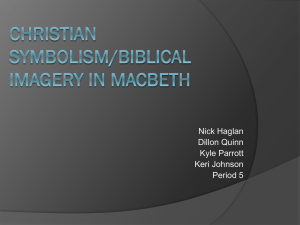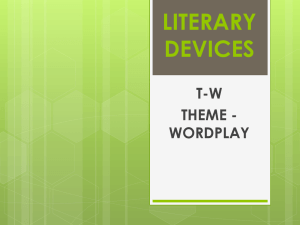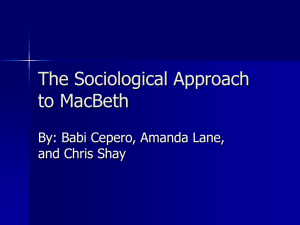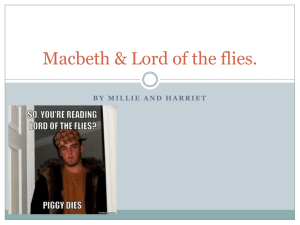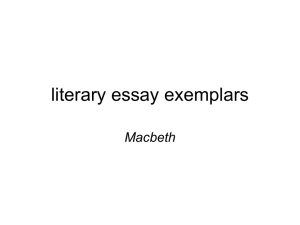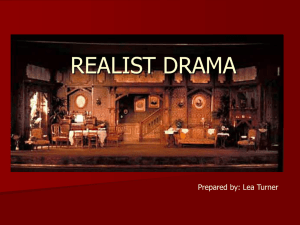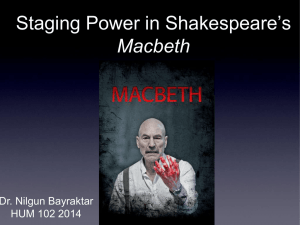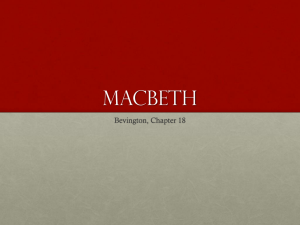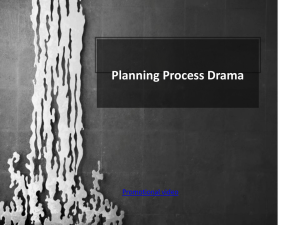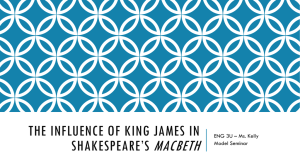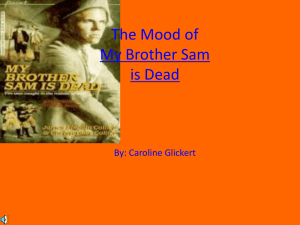Literary Analysis
advertisement
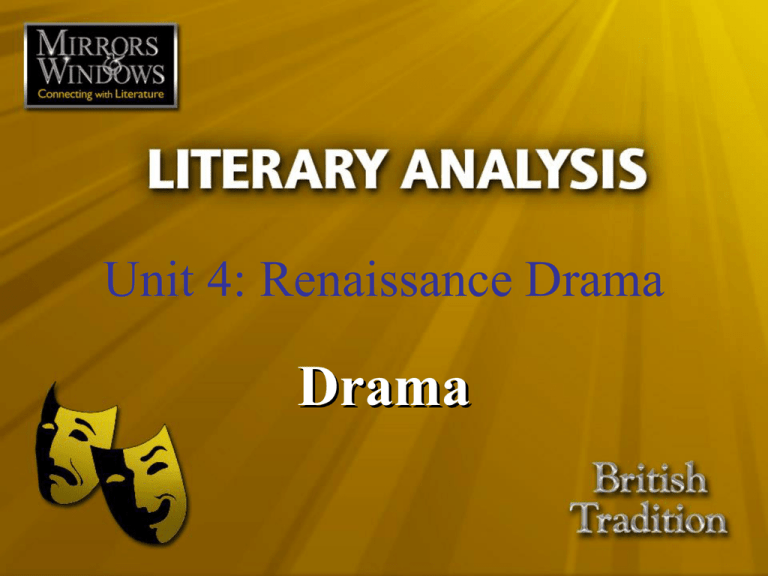
Unit 4: Renaissance Drama Drama Drama, instead of telling us the whole of a man’s life, must place him in such a situation, tie such a knot, that when it is untied, the whole man is visible. —Leo Tolstoy What is drama? • Drama is a story told through characters played by actors. How is drama different from other literary genres? • Drama, unlike other types of literature, has the element of spectacle. • Spectacle is the visual portrayal of meaning. • To achieve spectacle, drama features unique elements, such as – lighting and costumes – set design and props – music and sound effects Who are your favorite dramatists? • • • • • • • • William Shakespeare August Wilson Lorraine Hansberry Arthur Miller Henrik Ibsen Eugene O’Neill Oscar Wilde Wendy Wasserstein What are the purposes of drama? • Drama can – entertain viewers – enlighten viewers by sharing the human condition or experience – help viewers gain insight into themselves and others – teach viewers empathy – allow viewers to explore other visions of the world Types of Drama • Most dramas can be categorized as either comedy or tragedy. – These classifications date back to the 5th century BCE in Greece. • However, the distinctions between these two types of drama have changed since earlier times. Ancient Greek Comedies • Ancient Greek comedies were satires that mocked public figures for their foolish ways in solving problems. – Actors portrayed these figures as buffoons. • Public institutions and stereotypes were also made into objects of ridicule. – This was done through the recitation of dialogue and the singing of bawdy songs. Shakespeare’s Comedies • During the English Renaissance (1485–1642), Shakespeare led a revival in drama and wrote several comedies. – These comedies were typically lighthearted works that touched on serious themes. – Action in Shakespeare’s comedies usually progressed from initial order to humorous misunderstanding and back to order again. – Often, his comedies ended with a marriage. Contemporary Comedies • Today, the term comedy refers to any lighthearted or humorous literary work. • Contemporary stage comedies have leading characters whose foolish actions in solving problems lead to humorous situations. • Typically, contemporary comedies happy endings. have Ancient Greek Tragedies • Ancient Greek tragedies were stories about the fall of strong individuals of high status, either by their own undoing or by the hand of Fate. • This tragic fall led to the ruination of some aspect of the noble individual’s life, such as – – – – the tarnishing of virtuous character the fracturing of relationships the lowering of social status the sealing of fate Shakespeare’s Tragedies • During the English Renaissance, Shakespeare also wrote several tragedies. – These tragedies closely followed the Greek tragedy format. – They told stories of the downfall of persons of high status. – The fall of these heroes was typically brought about by some tragic flaw in their character. – Often, these tragedies celebrated the courage and dignity of the heroes in the face of doom. Contemporary Tragedies • Today, the term tragedy describes both – a play about the downfall of a sympathetic character, or protagonist, and – a story with an unhappy ending • Contemporary stage tragedies have leading characters that represent common individuals. – Their weaknesses, or tragic flaws, become apparent as the drama unfolds. Mixed Types of Drama • Other types of drama blur the lines between tragedy and comedy, including – Theater of the Absurd, in which characters are unpredictable, situations are improbable or meaningless, and dialogue is filled with wordplay – melodramas, in which characters triumph over serious or tragic circumstances in their lives – tragi-comedies, in which the dialogue and actions of characters provide insights into complicated issues, such as love, relationships, or death Dramatic Structure • Once a playwright chooses a type of drama, he or she must organize the script into a dramatic structure. • To do this, a playwright borrows elements from fiction, such as characters, setting, and plot structure. • These elements are then placed into parts unique to drama: acts and scenes. Acts and Scenes • Acts are the major divisions of a play. • Acts are often divided into scenes, or shorter sections that usually mark changes of time and place. PROGRAM ACT I Scene 1 Scene 2 Scene 3 ACT II Dramatic Structure: Five-Act Play • Most plays written in Shakespeare’s time have a dramatic structure composed of five acts. • For example, The Tragedy of Macbeth is a five-act play. Dramatic Structure: Five-Act Play • A five-act play has the same plot structure as a work of fiction. – It has an exposition, rising action, climax or crisis, falling action, and dénouement. • Each act is assigned to a particular part of the plot structure. – See the diagram on the next slide. Dramatic Structure: Five-Act Play Climax or Crisis (Act III) Exposition (Act I) Inciting Incident (Act I) Dénouement (Act V) Resolution or Catastrophe (Act V) Five-Act Play: Act I • Act I contains the exposition, or introduction. – The setting and main characters are presented. – The inciting incident (the event that sets in motion the central conflict) is introduced. Climax or Crisis (Act III) Exposition (Act I) Inciting Incident (Act I) Dénouement (Act V) Resolution or Catastrophe (Act V) Five-Act Play: Act II • Act II presents the rising action, a series of events that complicate the plot. – The suspense builds as the plot “thickens.” Climax or Crisis (Act III) Exposition (Act I) Inciting Incident (Act I) Dénouement (Act V) Resolution or Catastrophe (Act V) Five-Act Play: Act III • In Act III, suspense peaks in the climax or crisis, when something decisive happens to determine the future course of events. – This is the play’s turning point. Climax or Crisis (Act III) Exposition (Act I) Inciting Incident (Act I) Dénouement (Act V) Resolution or Catastrophe (Act V) Five-Act Play: Act IV • Act IV presents the falling action—the consequences of the action taken in the climax. Climax or Crisis (Act III) Exposition (Act I) Inciting Incident (Act I) Dénouement (Act V) Resolution or Catastrophe (Act V) Five-Act Play: Act V • Act V presents the resolution or dénouement— the event that resolves the central conflict. – In a tragedy, this event is called the catastrophe because it marks the fall of the central character. Climax or Crisis (Act III) Exposition (Act I) Inciting Incident (Act I) Dénouement (Act V) Resolution or Catastrophe (Act V) Dramatic Characters • Aside from plot structure, dramas also share another similarity with a work of fiction: the actions and dialogue of characters. • However, unlike fiction, drama brings these characters to life by having actors portray them on stage. Dramatic Characters • By watching these stage actors, viewers can see and hear the many facets of the play’s characters, including their – – – – – – personalities motives emotional states relationships attitudes life experiences Dramatic Characters • Dramatic characters also share other similarities with characters in a work of fiction. They can be classified as – – – – major or minor characters protagonists or antagonists round or flat characters static or dynamic characters Major Characters • Major characters – play important roles in the plot of a drama – are multi-faceted or round characters – undergo some type of change during the course of a drama Protagonist and Antagonist • Major characters can be classified as protagonists or antagonists. • The protagonist has the central role in a dramatic script. • The antagonist works against the protagonist, and this friction or tension creates the conflict in the story line. Tragic Hero and Tragic Flaw • The tragic hero is a common protagonist in ancient Greek and Shakespearean tragedies. • The hero’s weakness of personality, or tragic flaw, causes him or her to make poor choices. • Examples of common tragic flaws are listed in the box below. arrogance stubbornness jealousy ambition/power indecisiveness inaction gullibility hypocrisy desire/lust fearfulness selfishness vulnerability Tragic Hero • A tragic hero in a classical tragedy – – – – is frequently a male figure is a member of the nobility or an esteemed leader is responsible for his or her own fate makes choices that lead to self-destruction or the ruination of relationships – suffers deeply, therefore inciting sympathy from the audience – becomes more self-aware as a result of the suffering Minor Characters • Minor characters play lesser roles in a drama. • They are flat characters who lack complexity and typically remain unchanged throughout a play. • They provide insight into the major characters by either highlighting or contrasting the qualities of the major characters. Foils • Foils are minor characters whose personalities serve to highlight the weaknesses of the main character or tragic hero. • In The Tragedy of Macbeth, Banquo is a foil to Macbeth. • For example, when a trusting Macbeth wants to believe the evil witches’ prophecies, a dubious Banquo warns him to be cautious. Comic Relief • Another type of minor character in classical tragedy is a humorous character who provides comic relief. • Comic relief is a technique used by playwrights to provide a break from the emotional intensity of a play. • In The Tragedy of Macbeth, the drunken Porter who guards the gates of Macbeth’s castle provides comic relief. Dramatic Speech • Because they are meant to be read out loud, dramatic works rely primarily on the speech of the characters to tell a story. • Powerful dramatic speech engages the audience with its eloquence and emotional intensity. Types of Dramatic Speech • There are four types of dramatic speech that playwrights use in their scripts: – – – – dialogue monologue soliloquy aside Dialogue • A dialogue is a conversation between two or more characters. • Dialogue can reveal a character’s – – – – – – – age personality and mood ethnic background educational level geographical roots relationships and their status motivations and aspirations Dialogue and Theme • Besides establishing characterization, dialogue can also hint at the theme and tone of a drama. • Theme is the central idea or perception about life that is revealed through a literary work. • Tone is the emotional attitude toward the reader or toward the subject implied by a literary work. Theme and Motif • Sometimes, a drama’s theme can be inferred from the playwright’s use of a motif. • A motif is a recurring element in one or more works of literature or art. • The Tragedy of Macbeth uses the motif of disturbances in nature. – These disturbances serve as omens. – The turmoil of the outer natural world frequently reflects the inner turmoil of a character. Dialogue • In this dialogue excerpt from Act II, scene ii, Macbeth meets up with his wife in the aftermath of his murderous crime. MACBETH. I have done the deed. Didst thou not hear a noise? LADY MACBETH. I heard the owl scream and the crickets cry. Did not you speak? MACBETH. When? LADY MACBETH. Now. MACBETH. As I descended? LADY MACBETH. Aye. —from The Tragedy of Macbeth, by William Shakespeare Based on the dialogue exchange between Macbeth and Lady Macbeth shown on the previous slide, how would you describe the tone of this scene? Monologue • Another type of dramatic speech is a monologue—a long speech made by one character. • This type of speech is an expression of a character’s thoughts or feelings regarding another character or situation. • A monologue typically can be heard by other characters on stage. Monologue • In Act III, scene ii, Macbeth ponders the murder of Banquo. MACBETH. We have scorch’d the snake, not kill’d it; She’ll close and be herself, whilest our poor malice Remains in danger of her former tooth. But let the frame of things disjoint, both the worlds suffer, Ere we will eat our meal in fear, and sleep In the affliction of these terrible dreams That shake us nightly. Better be with the dead, Whom we, to gain our peace, have sent to peace, —from The Tragedy of Macbeth, by William Shakespeare Based on Macbeth’s monologue seen on the previous slide, what is the purpose and tone of this speech? What is revealed about Macbeth in this monologue? Soliloquy • Soliloquy is another type of dramatic speech. • A soliloquy is a speech that reveals a character’s true thoughts and feelings. • A soliloquy is delivered when the character is alone on stage. • Typically, a soliloquy offers an intimate glimpse into a character’s emotions or mind-set. Soliloquy • In Act II, scene i, Macbeth wonders if he is suffering a hallucination when he sees a dagger in his hand. MACBETH. Is this a dagger which I see before me, The handle toward my hand? Come, let me clutch thee: I have thee not, and yet I see thee still. Art thou not, fatal vision, sensible To feeling as to sight? or art thou but A dagger of the mind, a false creation, Proceeding from the heat-oppressed brain? —from The Tragedy of Macbeth, by William Shakespeare Based on Macbeth’s soliloquy seen on the previous slide, what is the purpose and tone of this speech? What is revealed about Macbeth in this soliloquy? Aside • An aside is another type of dramatic speech. • In an aside, a character reveals to the audience his or her innermost thoughts and feelings about a topic. • This technique allows the audience—and no other characters on stage—to hear the character’s desires and motivations. • This aids in the audience’s understanding of subsequent events. Aside • In Act IV, scene i, Macbeth resolves to change his behavior so that he can achieve his desires. MACBETH. [Aside.] Time, thou anticipat’st my dread exploits: The flighty purpose never is o’ertook Unless the deed go with it. From this moment The very firstlings of my heart shall be The firstlings of my hand. And even now, To crown my thoughts with acts, be it thought and done: The castle of Macduff I will surprise, —from The Tragedy of Macbeth, by William Shakespeare Verbal Irony • Dramatic speech may also include the use of verbal irony. • Verbal irony is when a character says one thing but means another. • Verbal irony is similar to sarcasm. • What examples of verbal irony can you find in The Tragedy of Macbeth? Other Types of Irony • Two other types of irony are also common in dramas: – Dramatic irony is when something is known by the reader or the audience but is not known by the characters. – Irony of situation is when an event occurs that violates the expectations of the characters, the reader, or the audience. Stage Directions • The way in which characters deliver their lines sets the tone for each scene in a play. • To help actors determine how to do so, a playwright writes stage directions that describe how something should be performed on stage. • Stage directions also include notes on the staging of the play: set design, lighting, costumes, props, music, and sound effects. SUMMARY: Drama • To gain a better understanding of drama, ask yourself the following questions: – How does the plot structure lend itself to the content and theme of the drama? – What are the individual roles of the dramatic characters? What are their objectives and motives? – How does the dramatic speech develop the characters and advance the plot? – What do the stage directions reveal about the staging of the drama?
